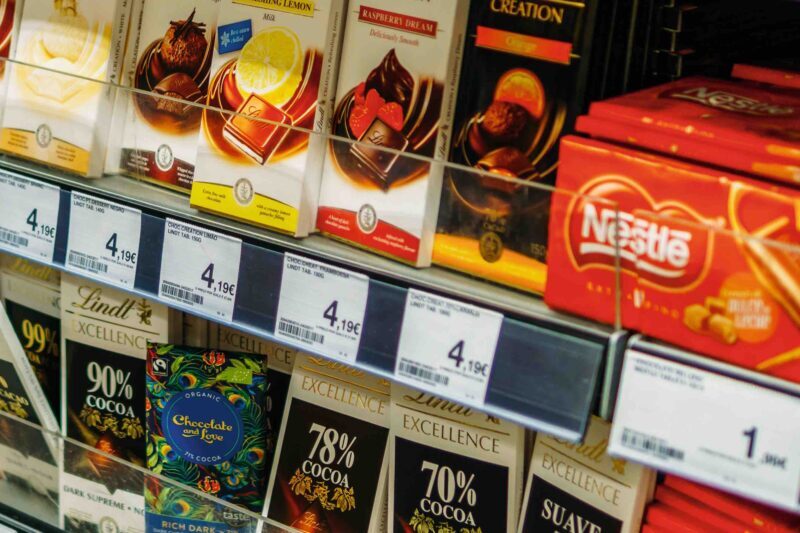FDF says sector faces ‘significant medium term challenges,’ with confectionery among categories hit by high inflation

Steep pre-Christmas price rises averaging 16.9% in December across food categories including confectionery has placed continued pressure economic pressure on UK households, facing inflation at a near 40-year high, according to Food and Drink Federation studies, reports Neill Barston.
Industry observers have continued to express concern at the situation, with the cost of living crisis continuing to bite for many consumers, with an upward curve of costs being felt by the ongoing impact of the war in Ukraine, as well as an increase in the cost of ingredients for many segments such as sweets and snacks, also affected by Brexit-related trading complications.
The 16.9% price rise follows a 16.5% hike in November, with the latest figures being notably above the present level of UK inflation which is at 10.5% – significantly over government targets of 2%, resulting in a notably turbulent period.
As the UK’s FDF noted, basics including milk, cheese and egg have witnessed significant cost increases, with confectionery costs also rising steeply, just at a period when manufacturers have hoped for peak sales ahead of Christmas – prompting many families to tighten spending ahead of a widely-anticipated recession. By category, sugar was up a huge 38%, ice cream was up by 18% in cost, honey 21%, and crisps by 14%.
According to the latest Office for National Statistics (ONS) data, the economy grew at the smallest level possible of 0.1% in November, narrowly avoiding what would have been classified as a recessionary period of two quarters of stagnant growth. But with household spending seriously curtailed and inflation remaining stubbornly highly, market analysts have forecast that 2023 will prove an exceptionally challenging year.
Karen Betts, chief executive of The Chief Executive of the Food and Drink Federation, said:“Food and drink prices have risen for the seventeenth consecutive month, to 16.9%. These rises continue to be driven by the aftermath of the disruption of COVID-19, the war in Ukraine and poor harvests caused by extreme weather last year – including widespread drought across Europe. The increased costs of ingredients, energy, packaging and the movement of goods in and out of the UK alongside the relative weakness of the pound have only made the situation worse for UK manufacturers.
“The government’s continued energy support is welcome and will help to contain food and drink price inflation. But there’s certainly more the UK government could be doing to help keep costs down for households – including by urgently simplifying current and prospective regulation.”
2023 major challenges
As Dr Liliana Danila, lead economist for the FDF observed, based on present patterns, prices will have continued rising throughout December (with latest data at the end of the month), with UK-sourced ingredients up 18.8% in October, and imported ingredients were 31.0% more expensive.
The specialist noted that falling gas prices were to be seen as a positive lsat month, but not that overall, 2022 global food prices were 51% higher than in 2019, with vegetable oils prices more than doubling (126%). While oil prices are less than mid 2022, they remain higher than pre-pandemic costs. Freight rates have increased according to a level 80% above pre-Covid prices, but are now said to be reducing.
Dr Danila believed there were still ‘significant medium term challenges remained, despite some pressures easing. She added : “If these trends continue, food inflation is likely to peak in mid-2023. The not so good news is that it will take a while for households to reap these benefits, as manufacturers’ forward contracts with suppliers and fixed-term contracts with customers mean it takes between seven to twelve months for changes in producer costs to feed through onto shop prices.
“Unsurprisingly, this impacts the most vulnerable households the most. In November, UK real incomes fell by 2.6%, despite the strongest rise in nominal pay of 6.4% since records began in 2001, the pandemic period notwithstanding. The ONS reported in December 2022 about half (51%) of adults in Great Britain reported buying less when food shopping in the last two weeks, above the figure of 10% a year ago. The BRC-KPMG sales figures saw strong headline growth in food and drink sales in December, but volumes were essentially flat, showing that the festive mood had its limits when it came to spending.”
Speaking to Confectionery Production, the Food and Drink Federation’s chief scientific officer Kate Halliwell believed that an update of the UK’s regulatory framework was to be welcomed, but noted concerns over the limited time available to implement any changes under the EU Retained Law Bill as it presently stands.
She said: “UK manufacturers make high quality, tasty and safe food and drink that millions love to eat, both here and abroad While we fully support the need for domestication and consolidation of our laws, we have strong concerns the scale and complexity of the review makes the 31 December sunset challenging to achieve and undermines the ability for governments to give this the proper consideration required.
“For the benefit of producers and consumers it is essential governments across the UK ensure any changes to regulations don’t negatively impact on our food safety or undermine our access to valuable export markets.”
